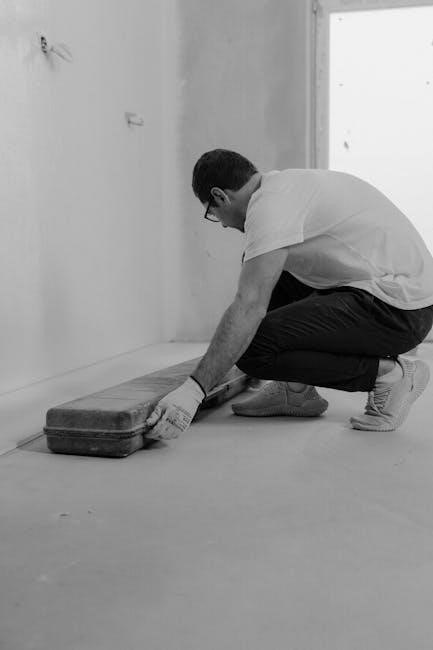rebuilding a manual transmission
Rebuilding a manual transmission is a cost-effective and rewarding process, allowing drivers to restore performance and extend vehicle life. It requires mechanical skills, patience, and the right tools to ensure success.
Overview of the Process
Rebuilding a manual transmission involves a systematic approach to disassemble, inspect, and replace worn or damaged components. The process begins with removing the transmission from the vehicle, followed by disassembling the case and internal parts. Each component is evaluated for wear or damage, and necessary replacements are made. Key steps include replacing gears, bearings, seals, and gaskets. After reassembly, the transmission is tested to ensure proper function. This process requires mechanical aptitude, specialized tools, and attention to detail to restore optimal performance and reliability.
Importance of Proper Tools and Preparation
Proper tools and preparation are critical for a successful manual transmission rebuild. Specialized tools like bearing pullers and a hydraulic press are essential for safely removing and reinstalling components without damage. A clean, well-organized workspace ensures parts are protected from contamination and helps prevent losing small items. Consulting a repair manual specific to your transmission model is vital for accurate guidance. Adequate preparation saves time, reduces frustration, and prevents costly mistakes. Investing in the right tools and environment ensures a smooth, efficient rebuilding process.

Tools and Equipment Required
Essential tools include wrenches, screwdrivers, and a socket set. Specialized equipment like bearing pullers and a hydraulic press are necessary for safe and precise component handling.
Essential Tools for the Job
Rebuilding a manual transmission requires a mix of basic and specialized tools. Essential tools include a socket set, wrenches, screwdrivers, and pliers. A torque wrench ensures proper bolt tightening. A hydraulic press is necessary for removing and installing bearings. Bearing pullers are crucial for safely extracting bearings without damage. Additionally, a set of punches and chisels aids in removing and aligning components. These tools are fundamental for disassembling, inspecting, and reassembling the transmission effectively. Having the right tools on hand ensures the rebuild process is efficient and avoids costly mistakes.
Specialized Tools and Their Uses
Specialized tools are indispensable for a manual transmission rebuild. A bearing press is used to install bearings without damage, ensuring proper alignment. A gear puller safely removes gears from shafts, preventing wear. A synchro ring installer aligns and seats synchromesh rings accurately. A dial indicator measures shaft end play and bearing preload, ensuring precise adjustments. These tools, often specific to transmission models, are crucial for handling intricate components and ensuring a smooth rebuild process. They minimize the risk of damage and help achieve professional-grade results.
Preparation and Planning
Preparation and planning are crucial for a successful manual transmission rebuild. Gather all necessary parts, tools, and manuals beforehand. Ensure a clean, well-lit workspace and adhere to safety protocols to avoid accidents and ensure efficiency.
Gathering Parts and Manuals
Gathering all necessary parts and manuals is essential for a smooth rebuild. This includes purchasing a complete rebuild kit, bearings, seals, and any worn components. Ensure you have the vehicle’s service manual or a transmission-specific guide. These resources provide detailed instructions, torque specifications, and diagrams. Additionally, source specialty tools like bearing pullers and a hydraulic press. Verify parts compatibility with your transmission model to avoid mismatches. Organize everything in a clean workspace to maintain efficiency throughout the process.
Workspace Setup and Safety Precautions
Setting up a clean, well-lit workspace is crucial for efficiency and safety. Cover the floor with a drop cloth to protect it from grease and debris. Use jack stands to securely lift and support the vehicle, ensuring it cannot fall. Wear protective gear, including gloves, safety glasses, and a face mask. Keep a fire extinguisher nearby and avoid working near open flames. Organize tools and parts in labeled containers to prevent misplacement. Proper ventilation is essential when working with chemicals like cleaning solvents. Refer to your manual for specific safety guidelines related to your transmission model.

Disassembly of the Transmission
Disassembling the transmission involves removing it from the vehicle and carefully taking apart the case to access internal components for inspection and replacement.
Removing the Transmission from the Vehicle
Removing the transmission from the vehicle is a critical step that requires careful planning and execution. Start by disconnecting the battery and draining the transmission fluid. Next, remove the driveshaft and any components connected to the transmission, such as the gearshift linkage and clutch assembly. Use a jack or lifting equipment to support the transmission. Finally, unbolt the transmission from the engine and carefully lower it onto a transmission jack or workbench, ensuring it’s stable and secure for disassembly.
Disassembling the Transmission Case
Disassembling the transmission case involves carefully removing the bolts and separating the housing. Begin by using a socket set or wrench to remove the case bolts, working in a pattern to avoid warping the housing. Gently pry the case apart using a soft-faced hammer or pry bar, taking care not to damage the mating surfaces. Once separated, the case will reveal the internal components. Be cautious of bearings or gears that may fall out during disassembly. Organize all removed parts to ensure they are accounted for during reassembly. Proper disassembly is key to a successful rebuild.
Identifying and Removing Internal Components
After disassembly, identify internal components such as gears, bearings, shafts, and synchronizers. Use a service manual to map each part. Carefully remove bearings using a press or pullers. Gears and shafts often require specific tools for extraction. Synchronizers and rings are typically removed with specialized tools to avoid damage. Document each part’s location and condition for reassembly. Organize components in labeled containers to prevent loss or confusion. This step ensures accuracy and efficiency when rebuilding, allowing for a precise and successful restoration of the transmission’s functionality and performance.
Inspection and Assessment
Inspecting gears and bearings for wear and damage is crucial. Check for cracks, scoring, or excessive play. Assess seals and gaskets for leaks or deterioration. Proper evaluation ensures effective repairs and prevents future issues.
Evaluating Gears and Bearings
Evaluating gears and bearings involves inspecting for wear, scoring, or cracks. Check each gear tooth for chipping or excessive wear. Bearings should be examined for smooth rotation and any signs of pitting or damage. Proper assessment ensures that all components are in good condition or need replacement. This step is critical to maintaining the transmission’s performance and longevity. Any damaged parts must be replaced to prevent further issues. Use specialized tools to measure play and ensure precise fits during reassembly.
Checking for Wear and Damage
Checking for wear and damage involves inspecting each component for signs of deterioration. Look for excessive play in gears, scoring on shafts, and worn synchronizers. Bearings should be checked for smooth operation and any signs of pitting. Clutch packs and seals may show wear, leading to leaks or slippage. Inspect gear teeth for chipping or cracking, and assess the condition of the transmission case for damage. Proper evaluation ensures that all worn or damaged parts are identified and replaced, preventing future issues and ensuring smooth operation after the rebuild.

Replacing Worn or Damaged Parts
Replace worn gears, bearings, and seals with new components. Use a hydraulic press for bearings and ensure all parts are properly aligned and secured.
Installing New Gears and Bearings
Begin by preparing the transmission case for new components. Install gears, ensuring proper alignment and fitment. Use a hydraulic press to seat bearings securely. Apply a thin layer of grease to gear teeth and bearing surfaces for lubrication. Carefully align and slide the shafts into place, verifying proper engagement. Ensure all components are torque-specific to manufacturer specifications. Double-check alignment and seating before proceeding to reassembly. This step requires precision to ensure smooth operation and longevity of the transmission.
Replacing Seals and Gaskets
Replacing seals and gaskets is crucial to prevent leaks and ensure proper lubrication. Begin by cleaning all surfaces thoroughly. Apply a thin layer of RTV silicone to gasket surfaces for a tight seal. Install new seals using a seal driver to avoid damage. Pay special attention to the input and output shaft seals, as these are prone to wear. Use a gasket installer for precise alignment. Allow the RTV to cure slightly before reassembling. Double-check all connections to ensure no leaks. This step is vital for maintaining transmission reliability and performance over time.

Reassembly of the Transmission
Reassembly requires meticulous attention to detail, ensuring all components are clean and properly aligned. Reverse the disassembly process, starting with internal parts before refitting the case.
Reassembling Internal Components
Reassembling internal components requires precision and care. Begin by cleaning and inspecting all parts thoroughly. Reverse the disassembly process, starting with the gearsets and bearings. Use a hydraulic press or bearing pullers for stubborn parts. Ensure proper alignment and torque specifications for each component. Reinstall the gearbox shafts, pilot bearing, and input shaft, checking for smooth operation. Pay special attention to synchromesh mechanisms and gear engagement teeth. Lubricate all moving parts generously to prevent wear. Proper reassembly ensures optimal performance and longevity of the transmission.
Refitting the Transmission Case
Refitting the transmission case requires meticulous care to ensure proper alignment and sealing. Clean and inspect the case thoroughly before reassembly. Apply a thin layer of sealant to the gasket surfaces and carefully align the case halves. Use a torque wrench to secure the bolts in the recommended pattern and sequence. Tighten gradually to avoid warping the case. Ensure all ports and openings are clear of debris. Once refitted, verify the case alignment with the engine and chassis. Double-check all connections and components for proper fitment and security.

Testing and Adjustment
Testing involves checking for leaks, proper gear engagement, and smooth operation. Adjustments ensure optimal performance, addressing any issues before final installation and test driving the vehicle.
Initial Testing and Adjustment
Initial testing involves verifying smooth gear shifts and ensuring no leaks. Adjustments focus on clutch alignment, gear engagement points, and synchronizer function. Proper setup ensures reliability and performance.
Final Check and Test Drive
A final inspection ensures all components are securely fastened, and fluid levels are correct. A test drive verifies smooth operation, checking for unusual noises, vibrations, or gear issues. Documenting the process aids in future maintenance and troubleshooting, ensuring long-term reliability and performance.

Troubleshooting Common Issues
Identifying and resolving post-rebuild problems involves diagnosing symptoms like gear slippage or noise, ensuring proper alignment, and verifying fluid levels for optimal transmission performance.
Identifying and Resolving Post-Rebuild Problems
After rebuilding, common issues include gear slippage, noisy operation, or difficulty shifting. Inspect for misaligned components, worn bearings, or improper torque specifications. Check fluid levels and condition, as contamination can cause malfunction. Ensure all seals and gaskets are properly seated to prevent leaks. If problems persist, consult the repair manual or seek professional assistance to diagnose and correct any overlooked details during the rebuild process.
